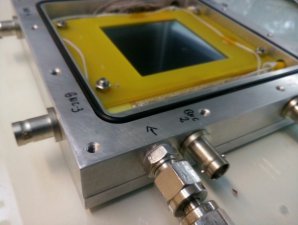Portugal: Resistive Plate Chambers (RPCs)

The building of the ESS in Lund, Sweden will provide a high-flux neutron source. It requires new detectors, including thermal neutron position sensitive detectors (PSNDs), to meet the increasing demands of the neutron community and to realise its full potential. New detectors that will be based here, and at other neutron sources worldwide, also need to provide an alternative to current detectors that commonly use Helium-3 (3He), a gas that is becoming more difficult and expensive to obtain.
Here LIP step in with their expertise on Resistive Plate Chambers (RPCs). These devices are mainly used in large-area detectors in high-energy and astroparticle physics because they provide good time AND spatial resolution. They are well-established, reasonably cheap to make and their layered configuration makes their design flexible. However, until now they have never been used in neutron scattering applications or as position-sensitive thermal neutron detectors capable of providing sub-millimeter spatial resolution and high neutron detection efficiency.
Neutrons cannot normally be detected by standard RPCs because they have no charge and cannot directly ionise the medium they pass through. However, and as happens in other types of neutron detectors, RPCs can be made sensitive to neutrons by covering their electrodes with so-called neutron converters, which are able to capture neutrons. Capture of a neutrons leads to emission of charged particles which, in turn can be detected by the RPC.
Possible thermal neutron converter isotopes are Helium-3 (3He), Lithium-6 (6Li), Boron-10 (10B), Gadolinium-157 (157Gd). With Helium running out worldwide, it is 10B that often provides the most promising alternative. This isotope has a good natural occurrence and reasonably high neutron capture cross-section (70% of that of Helium-3). It is often used in the form of B4C thin films enriched in 10B.
Luís Margato and his team at LIP have been looking at introducing 10B thin films into RPC electrodes in order to make them sensitive to thermal neutrons.The aim is to make them thermal neutron detectors with high time- and 2D spatial resolution. This will introduce a high performance and low cost detector technology. It is hoped that sub-millimeter and maybe even 100 µm spatial resolutions can eventually be achieved. The combination of high detection efficiency, very good spatial resolution and fast timing capability (sub-nanosecond range) opens the possibility of applying the 10B4C lined RPCs in time-resolved or energy-resolved (TOF) neutron imaging.
For a bit more information on the RPC project, read our report from 2016.
Reference: L. M. S. Margato, A. Morozov, Boron-10 lined RPCs for sub-millimeter resolution thermal neutron detectors: Conceptual design and performance considerations
Acknowledgements: Luís Margato, LIP
Back to The Road to the ESS
Other articles: RPCs – How they work, RPCs: Results so far, LIP, Detectors




